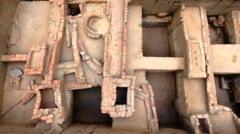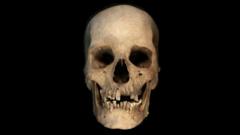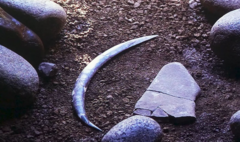Underneath a soccer field in Vienna, archaeologists have made a significant discovery: a mass grave believed to be linked to the Roman Empire’s conflicts with Germanic tribes nearly 2,000 years ago. The findings were announced this week by a team from the Vienna Museum after the grave was unearthed during renovations in the Simmering district last October.
Experts determined that the remains belong to at least 129 individuals, many of whom show signs of having suffered injuries sustained in battle. Radiocarbon dating has placed the grave's existence roughly between A.D. 80 and 234, a tumultuous period marked by multiple Roman emperors, including Domitian and Trajan, who were known to have engaged in military confrontations with the Germanic peoples in the region.
Among the artifacts recovered from the site were an iron dagger, lance points, pieces of scale armor, and a cheek piece from a helmet. Notably, the presence of shoe nails identified as coming from Roman military footwear—specifically caligae—provides further indication of the grave's martial context.
Michaela Binder, the lead anthropologist, emphasized the uniqueness of this find. She noted the rarity of discovering uncremated human remains from this era, as ancient Romans typically practiced cremation until the third century A.D. "It is an absolute unique chance to study the life histories of people in the first century A.D.,” she stated. This mass grave not only signifies the violent history of Roman military engagements but also opens new avenues for understanding the intricacies of life during this pivotal time.
Experts determined that the remains belong to at least 129 individuals, many of whom show signs of having suffered injuries sustained in battle. Radiocarbon dating has placed the grave's existence roughly between A.D. 80 and 234, a tumultuous period marked by multiple Roman emperors, including Domitian and Trajan, who were known to have engaged in military confrontations with the Germanic peoples in the region.
Among the artifacts recovered from the site were an iron dagger, lance points, pieces of scale armor, and a cheek piece from a helmet. Notably, the presence of shoe nails identified as coming from Roman military footwear—specifically caligae—provides further indication of the grave's martial context.
Michaela Binder, the lead anthropologist, emphasized the uniqueness of this find. She noted the rarity of discovering uncremated human remains from this era, as ancient Romans typically practiced cremation until the third century A.D. "It is an absolute unique chance to study the life histories of people in the first century A.D.,” she stated. This mass grave not only signifies the violent history of Roman military engagements but also opens new avenues for understanding the intricacies of life during this pivotal time.



















